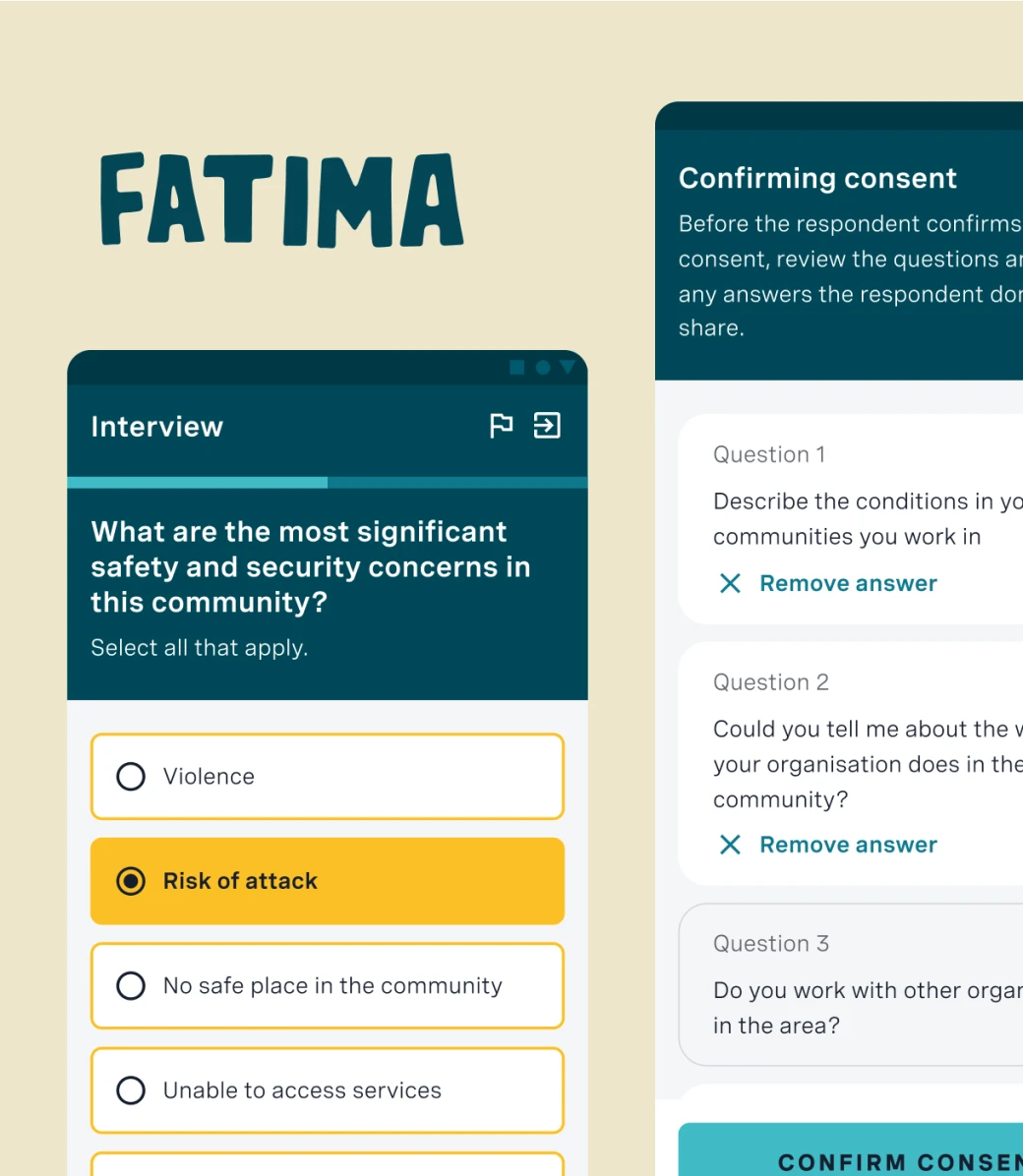How to run an inclusive, multi-language virtual meeting
As a design and technology studio working in the humanitarian sector, collaborating with teams simultaneously across multiple languages has significantly impacted our work at Here I Am. Conducting a virtual workshop where participants actively engage in discussions in more than one language is still awe-inspiring to be a part of. It breaks down communication barriers, and enhances collaboration, connecting us more effectively with our partners and the communities we design for.

However, the process is not perfect. If you’ve ever experienced a meeting or conference with interpretation, you know it can feel disjointed and requires heightened concentration. Furthermore, if that interpretation is AI generated, then it will often miss critical nuances in language, and in cultural terms. A human interpreter will incorporate these considerations and also add softness or harshness as needed, in order to aid fluent and clear communication.
In our commitment to inclusivity, we therefore remain advocates for live human interpretation for multi-language virtual meetings and have created a best practice guide with Marifé Caicedo, a professional live interpreter.
1. Set up the meeting for success
Use a platform that can enable live human interpretation
Firstly, you will need to use a video call platform that enables live human interpretation. This means that an interactive workshop can be conducted in multiple languages, allowing participants to not only listen in their own language, but to contribute and collaborate too.
Zoom is our preferred platform for this context due to its relatively easy setup for live human interpretation and intuitive language channel signposting. However, we have also compared the live interpretation and translation features available with Google Meet and Microsoft Teams, which you can read more about here.
Brief the interpreter ahead of time
Recruit an experienced Simultaneous Interpreter and share any context and updates with them approximately two days ahead of the session, allowing them to prepare. Even if materials are incomplete, some context will help them to familiarise themselves with the topics for the meeting.
This briefing session is also a good opportunity to get to know the interpreter and for them to raise any preferences and advice, given their experience. You should also test the connection and setup in this briefing.
Invite the interpreter to join the call early
Meeting the interpreter 5-10 minutes prior to the meeting will give you time to set up the language channels and to test them. At this point you should also agree with the interpreter how they will flag to you that they need some support. They may prefer to message the facilitator in a private channel, raise a hand to the whole group, or simply speak up if they need something clarifying or time to catch up. It is important that they have autonomy to interrupt the session to ensure that participants in all languages are up to speed with the content.
Take time to introduce the language channels
You should start the meeting by letting all participants know that there is interpretation and that the pace will be slower to accommodate this.
You will need to ask all participants to join their correct language channel. Even those joining in English must join the English channel, so that they can hear contributions from those on other language channels (interpreted into English).
Instructions for how to join the language channels should be vocalised and also added into the chat function in all relevant languages. Any late comers should be directed to these instructions too; we find a direct chat message is the least disruptive approach for this.
Record to the Cloud
Record meetings with interpretation on the Cloud. Do not record locally as the translated audio will not be saved.
Allow 30-50% more time for the session
In order to create an inclusive experience across all languages, you will need to make some adjustments to the pace of the session, as detailed below. This, alongside any technical complications with joining the correct language channel, can add up to 50% more time to a meeting. The extension required varies according to the number of participants, the number of languages and their familiarity with the topic.
Note that one interpreter should never work for longer than 60 minutes; two interpreters will need to join for anything longer than that.
2. Best practice for the speaker
Speak slowly and clearly
The most important change that you can make to your virtual meeting to enable effective interpretation is to speak slowly and clearly, in short sentences, with ample pauses after each sentence.
Interpreters need to digest what is being said and reframe it for the listener. Sometimes there may be new concepts to the interpreter that don’t directly translate, so they will need time to consider how to express the content accurately to the listener — and they are doing all this while the speaker continues.
Speakers should be reminded of this at the start of every session, and with the entry of every new speaker. It’s common that a speaker will start slowly, but speed up as they become more animated about the topic. Equally, when discussion begins between participants in the same language, this is also a common time that the pace increases. You should appoint someone who, alongside the interpreter, can keep an eye on this and advise the speakers to slow down as necessary.
Lose the jargon
Jargon, acronyms and language or culturally-specific expressions will all make the interpretation more complex. If an acronym is being used in a session, explain it clearly up front and ensure participants, across all language channels, have grasped it before repeating it throughout. If sector specific jargon is likely to be used, make sure the interpreter has descriptions ahead of time so they can study and use the terms correctly
Our colleague Marifé also notes the importance of considering the locality of references that you include in your content:
Many a time speakers will make references to, for example, baseball to make a point but that sport is not even known in other countries. Same with TV shows. Also sometimes jokes can also be difficult to translate.
Turn your video on
Interpreters lip read alongside listening in order to interpret at pace, so turn on your video and avoid covering your mouth when speaking. Video also allows them to see speaker expressions which aid their understanding.
Pause for questions and clarification
After each section of the session, pause and specifically ask participants across all languages if there is anything that they need clarifying.
Consider content being screen shared
If content being screen shared in a session is text heavy, you should aim to share a translated version with participants ahead of the session so that they can follow along from that document while you present. If it is light in text and sharing a translated copy isn’t possible, then you should build in the time for the interpreter to also translate the written text to the participants during the session.
Minimise background noise
Of course this is best practice for all virtual meetings, but all the more critical in this context. Ask all participants to mute unless speaking and suggest the use of a tool; such as Krisp to participants ahead of the meeting to optimise the audio.
3. Facilitating conversation
Invite participation from every language channel
Be deliberate in inviting participation from each different language channel throughout the session. Depending on the context, you can prompt individuals, or the language channel as a whole, to ensure that they feel as comfortable and confident to participate as possible.
You should also offer the opportunity to participate through the chat channel, if that feels easier for anyone.
Use emojis to aid contribution
For quick feedback on whether everyone has understood the discussion, use language agnostic methods such as emojis to gauge the group feedback. For example, ask everyone to add a thumbs up emoji if they understand the task. This can prompt people to speak up if they haven’t understood and indeed be telling if they haven’t understood the thumbs up instruction itself.
4. Learn and improve
Finally, in order to keep improving, we suggest asking the interpreters and participants across each language channel for feedback on the session.
We ask questions such as;
- How was the pace?
- How was the complexity of language?
- How was the ease of interaction?
- What could we have done to have better supported the participants on the non speaking language channel?
This ensures that we are constantly improving the productivity and inclusivity of our multi-language virtual meetings.
If you’d like to collaborate with Marifé Caicedo for professional live interpretation, you can find her on LinkedIn or email her at marifecaicedo@gmail.com
Inspired by this post?
We love to share perspectives, thoughts and ideas on creating digital ways to include the excluded. If you have a problem you'd like to discuss, we'd love to hear from you.




